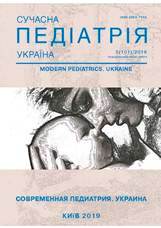Vein of galen aneurysm as an extracardiac cause of severe heart failure in the neonatal period
Abstract
Extracardiac arteriovenous malformations are considered to be an extremely rare cause of severe heart failure in the neonatal period. Intracranial arteriovenous malformation associated with the large-vein aneurysm of Galen (VGA) is the most common pathology among these malformations, due to impaired development of the embryonic precursor — Markovskiy's medial prosenecephalic vein. Presence of this congenital pathology significantly complicates the diagnostic search, since clinical manifestations are characteristic only for heart failure.Materials and methods. A clinical case of a newborn girl with VGA, who was admitted to the neonatal intensive care unit of the Regional Children's Hospital with signs of severe heart failure in January 2019. On the third day after birth, the child developed cyanosis (O2 saturation was 50%). There fore, congenital heart disease was suspected.
Results. On examination in the neonatal intensive care unit: cyanosis (50% saturation), dyspnea (respiratory rate 50–60 / min), tachycardia (heart rate 140–160 bpm) and significant swelling and pulsation of the neck veins, large fontanelle 3×3 cm in size, at the level of the bones of the skull, auscultation of the fontanel was not performed. Pulsation was determined on the femoral arteries, and the liver was enlarged (+4 cm) on palpation. During auscultation — pansystolic murmur across left lower sternal border 4/6 by Levine scale. Cardiomegaly (CTI>80%) with enhanced pulmonary pattern and hepatomegaly where revealed on the roentgenogram. During an echocardiographic examination, the child was diagnosed with dilated right heart chambers with tricuspid insufficiency, patent foramen ovale and a dilated innominate vein. After excluding the diagnosis of critical heart disease, neurosonography was carried out and a diagnosis was made — arteriovenous malformation — Vein of Galen aneurysm, which was confirmed on computed tomography.
Conclusions. Aneurysm of the vein of Galen is an extremely rare pathology, however, the swelling and pulsation of the cervical veins during the examination and the presence of severe cardiovascular insufficiency in newborns in the absence of congenital heart disease requires children's cardiologists to suspect and exclude arteriovenous malformation of the cerebral vessels. Endovascular treatment of VGA is considered the most effective, despite the high postoperative mortality.
The research was carried out in accordance with the principles of the Helsinki Declaration. The study protocol was approved by the Local Ethics Committee (LEC) of all institutions.
References
Alvarez H, Garcia Monaco R, Rodesch G, Sachet M, Krings T, Lasjaunias P. (2007). Vein of Galen aneurysmal malformations. Neuroimaging Clin N Am.17: 189–206. https://doi.org/10.1016/j.nic.2007.02.005; PMid:17645970
Andjenie Madhuban, Freek van den Heuvel, Margriet van Stuijvenberg (2016). Vein of Galen Aneurysmal Malformation in Neonates Presenting With Congestive Heart Failure. Child Neurology. 3: 2329048X15624704. Open. 2016 Jan/Dec. Published online 2016 Apr 4. https://doi.org/10.1177/2329048X15624704; PMid:28503603 PMCid:PMC5417289
Chevret L, Durand P, Alvarez H, Lambert V, Caeymax L, Rodesch G et al. (2002). Severe cardiac failure in newborns with VGAM.Prognosis significance of hemodynamic parameters in neonates presenting with severe heart failure owing to vein of Galen arteriovenous malformation. Intensive Care Med. 28: 1126—30. https://doi.org/10.1007/s00134-002-1381-8; PMid:12185436
Daniel Hansen, Peter T. Kan, Gaddum D. Reddy, Arvind Chintagumpala Mohan, Andrew Jea, Sandi Lam. (2016). Pediatric knowledge update: Approach to the management of vein of Galen aneurysmal malformations in neonates. Surg Neurol Int. 7 (12): 317—321. https://doi.org/10.4103/2152-7806.182415; PMid:27274404 PMCid:PMC4879847
Karam O, da Cruz E, Rimensberger PC. (2009). VGAM induced high-flow congestive heart failure responsive to PGE1 infusion. Int J Cardiol.132(2):e60/e62. https://doi.org/10.1016/j.ijcard.2007.08.020; PMid:18022260
Khullar D, Andeejani AM, Bulsara KR. (2010). Evolution of treatment options for vein of Galen malformations. J Neurosurg Pediatr. 6: 444—51. https://doi.org/10.3171/2010.8.PEDS10231; PMid:21039167
Lasjaunias PL, Chng SM, Sachet M, Alvarez H, Rodesch G, Garcia-Monaco R. (2006). The management of vein of Galen aneurysmal malformations. Neurosurgery. 59; 5(3): 184—94. https://doi.org/10.1227/01.NEU.0000237445.39514.16; PMid:17053602
McSweeney N, Brew S, Bhate S, Cox T, Roebuck DJ, Ganesan V. (2010). Management and outcome of vein of Galen malformation. Arch Dis Child. 95 (11): 903—909. https://doi.org/10.1136/adc.2009.177584
Mortazavi MM, Griessenauer CJ, Foreman P et al. (2013). Vein of Galen aneurysmal malformations: critical analysis of the literature with proposal of a new classification system. J Neurosurg Pediatr. 12(3): 293—306. https://doi.org/10.3171/2013.5.PEDS12587; PMid:23889354
Surasak Puvabanditsin, Rajeev Mehta, Kristy Palomares, Natalie Gengel, Christina Ferrucci-Da Silva, Sudipta Roychowdhury, Gaurav Gupta, Arun Kashyap, David Sorrentino (2017). Vein of Galen malformation in a neonate: A case report and review of endovascular management. World J Clinical Pediatr. 6 (1): 103—109. https://doi.org/10.5409/wjcp.v6.i1.103; PMid:28224101 PMCid:PMC5296625
Downloads
Issue
Section
License
The policy of the Journal “MODERN PEDIATRICS. UKRAINE” is compatible with the vast majority of funders' of open access and self-archiving policies. The journal provides immediate open access route being convinced that everyone – not only scientists - can benefit from research results, and publishes articles exclusively under open access distribution, with a Creative Commons Attribution-Noncommercial 4.0 international license (СС BY-NC).
Authors transfer the copyright to the Journal “MODERN PEDIATRICS. UKRAINE” when the manuscript is accepted for publication. Authors declare that this manuscript has not been published nor is under simultaneous consideration for publication elsewhere. After publication, the articles become freely available on-line to the public.
Readers have the right to use, distribute, and reproduce articles in any medium, provided the articles and the journal are properly cited.
The use of published materials for commercial purposes is strongly prohibited.

